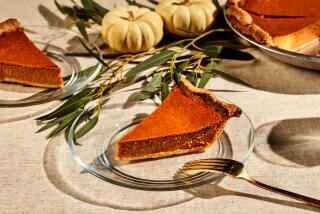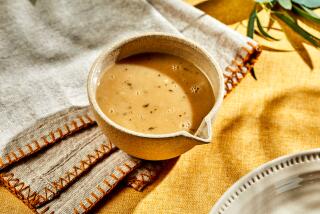A more flavorful dry-brined turkey

Thanksgiving is a holiday built on tradition. And, much to my surprise, I seem to have found a new one of my own -- writing about dry-brined turkey.
After more than 20 years of Thanksgiving stories, I didn’t think there was much left that could be said about turkey. But three years ago I wrote about a new technique I’d fallen in love with. And judging from the hundreds of happy e-mails I received, readers shared that affection.
I tweaked it a bit last year, to similar reaction, and now here I am writing about it again, with even more improvements.
At first glance, the recipe is so simple it’s hard to believe there could be anything to add, but it’s in the nature of cooking (or at least of recipe tinkering) to always move forward. We’re like great white sharks that way -- that and the whole eating-just-for-recreation thing.
In its most basic form, dry-brining is nothing more than salting turkey and letting it sit for several days. I based it on the Zuni Café chicken my friend Judy Rodgers has made famous at her San Francisco restaurant.
Dry-brined turkey is, if anything, even more remarkable. While turkey sometimes can be dry and bland, after dry-brining, the meat is moist and flavorful. And in an improvement over wet-brining (which I enthusiastically practiced for several years), the texture of the meat stays firm and muscular, with none of the sponginess that can result from added moisture.
Brining the bird
It couldn’t be simpler to do. Here’s how it works: Sprinkle the bird with salt, allowing about 1 tablespoon of kosher salt for every 5 pounds of turkey. That’s not a lot -- it won’t look like much more than what you’d normally apply just before roasting. And contrary to some published reports (I’m looking at you, Cook’s Illustrated!), you can sprinkle the salt right onto the skin; you don’t need to lift the skin and salt the meat.
Then stick the turkey in a sealed plastic bag and refrigerate. After a day or so, you might see some liquid in the bag. Don’t worry. Salt naturally pulls moisture from meat. Give the turkey a light massage through the bag to make sure the salt is distributed evenly and stick it back in the fridge.
After three days, you’ll see that the moisture has been reabsorbed by the meat, pulling the salt with it. At this point, if you’re a perfectionist, you can remove the turkey from the bag, put it on a plate and let it dry in the refrigerator for several hours (the fan in the refrigerator works very well as a skin-dryer). If you haven’t yet reached that level of obsession, you can just pat the skin dry with a paper towel; the skin may not be quite as brown or crisp, but few will notice.
Then you roast it. Start at 450 degrees to get the browning going, then after a half-hour or so, reduce to 325 to cook through. In the past, I’ve called for rotating the turkey during cooking so it browns more evenly. No more, it’s just too big a hassle considering the modest improvement in color.
So simple, how could you change it? Ha! You don’t know the power of a motivated tinkerer . . . or of curious readers.
My first major discovery came after several e-mails asking whether it could be done with frozen turkeys too, rather than adding three days of defrosting time onto the three days of dry-brining. It seemed like a good idea, so we tried it in the test kitchen and it worked perfectly.
So no longer do you have to buy your turkey a week in advance. Just rinse the frozen turkey in cool water (to start the defrosting process), pat it dry and salt it. Then proceed just as you would with a fresh turkey. By the time it’s defrosted, it’ll be seasoned and ready to go.
That makes dry-brined turkey much more convenient. Other reader e-mails prompted an idea that made it even more delicious. As originally constructed, with just plain salt, this recipe delivers a really deep, pure turkey flavor. It’s not overly salty, more like seasoned all the way to the bone.
But what about adding flavors? Especially for readers used to marinades and wet-brining, the whole “deep pure flavor” thing can seem a bit austere. What about adding different herbs or spices to the salt?
To find out, I rubbed a turkey breast with a mixture of salt ground with minced fresh rosemary and grated lemon zest. Yup again, great flavor, with just a hint of rosemary suffusing the breast meat. The lemon zest was barely detectable.
Just to be sure the flavor had really penetrated the meat and wasn’t just coating the surface, I cut some very wide slices, getting as much of the center of the muscle as I could, then tasted that by itself. The rosemary flavor was definitely there.
Aromatic options
I e-mailed Rodgers, to ask if she’d ever played with seasoning her salted meats. The answer was immediate and enthusiastic.
“YES! Salting early is a great trick on its own,” she wrote back, “but it has another virtue that should get more attention. Add aromatics to the salt. It’s a very big deal. A killer combo is black pepper and thyme on chicken or rabbit. Black pepper on steak makes the best pepper steak.
“In my testing, the approach works best when whatever aromatics you’re using are crushed just before combining with the salt and then rubbing on the meat.”
You can use a mortar and pestle, particularly if you’re using fresh herbs, or you can use a spice grinder, which is especially good for mixtures that include hard whole spices or dried herbs such as bay. I use one of those little electric “coffee grinders” from the grocery.
Then Rodgers added that the technique works even better if you let the meat warm nearly to room temperature before salting. “The flavor absorption goes faster, simply because the osmosis/reverse osmosis goes faster at warmer temps.”
She also shared very strong feelings about other kinds of marinades. “I rant regularly about the ineffectiveness of (non-)marinades (a marinade without salt is a ‘non-marinade’ in my book),” she wrote.
“Fancy non-marinades, full of pricey, photogenic aromatics promise, visually, to deliver exotic flavors to a dish, when, at best, they only leave fragile aromatic oils on the surface of things -- where they are likely to burn!
“But add salt to those aromatics and all those molecules of flavor piggy back on the salt and head right into cells of welcoming protein.”
Welcoming protein, indeed. As much as I love turkey, even I have to admit that sometimes the flavor can seem, well, a little subtle. It’s been accused of being non-vegetarian tofu, though I think that’s both cruel and false.
But I will admit that turkey does adapt quite well to introduced flavors. I liked the rosemary-lemon combination so much I was tempted to stop after that. But you know how recipe tinkering goes.
The first thought that came to mind was a kind of barbecue dry rub based on the one I use for pork ribs. Based on smoked paprika, similar to Spanish pimenton de la Vera, it took a little adjusting to get the flavor just where I wanted it. The trick, it turned out, was a good amount of fresh orange zest and just a hint of brown sugar to smooth out the acridity of the spices.
That is good, especially if you like a little bit of smoke on your turkey. But it’s far from traditional, so on this holiday above all others, that might not be appropriate.
So for my next seasoned salt, I used the most traditional Thanksgiving flavors I could think of -- sage and bay. And I learned that there is a very good reason these flavors are as widely used as they are: They add a really lovely undertone to the flavor of the turkey.
Once again, holiday tradition pays off. And I can’t wait to find out what I learn for next year.



